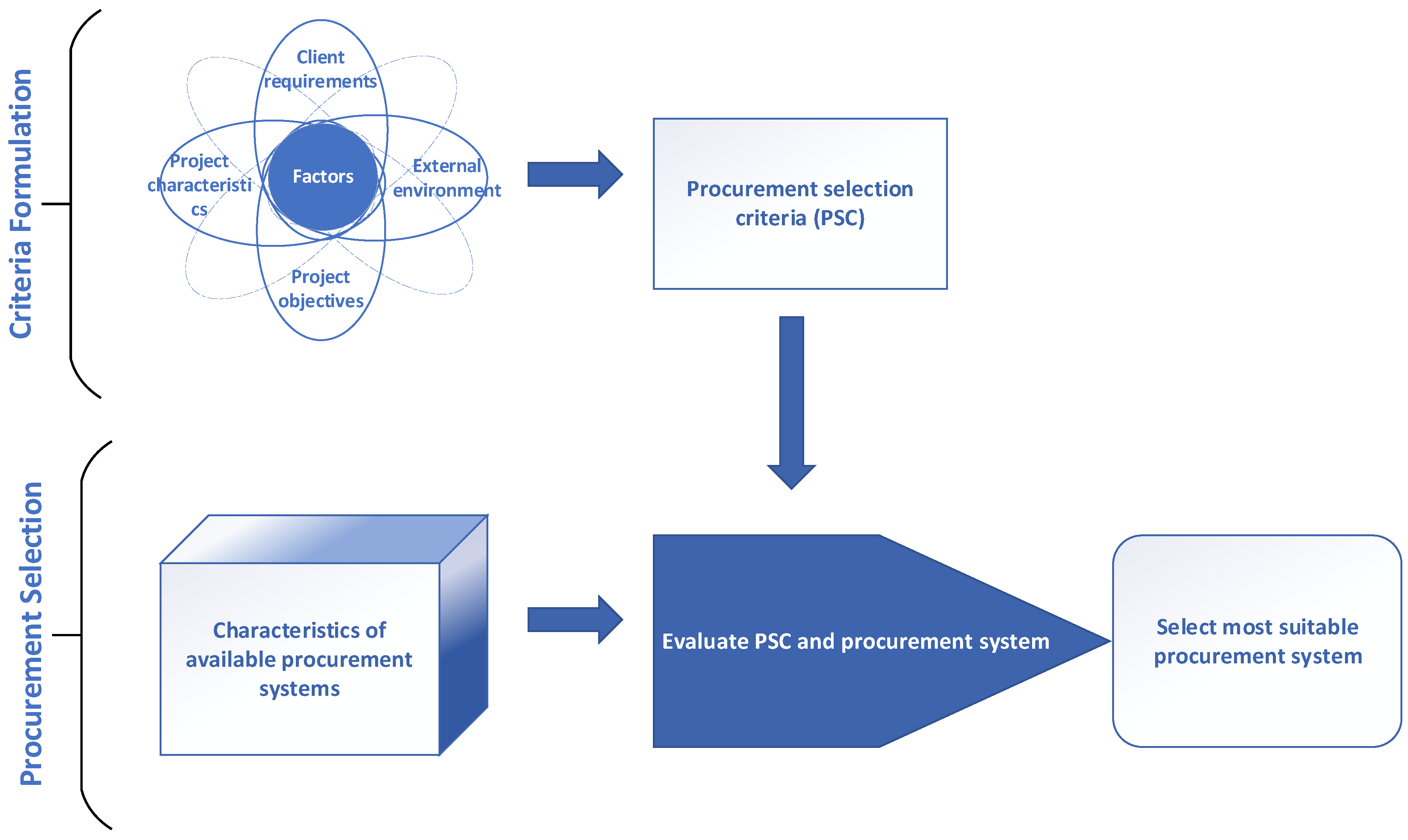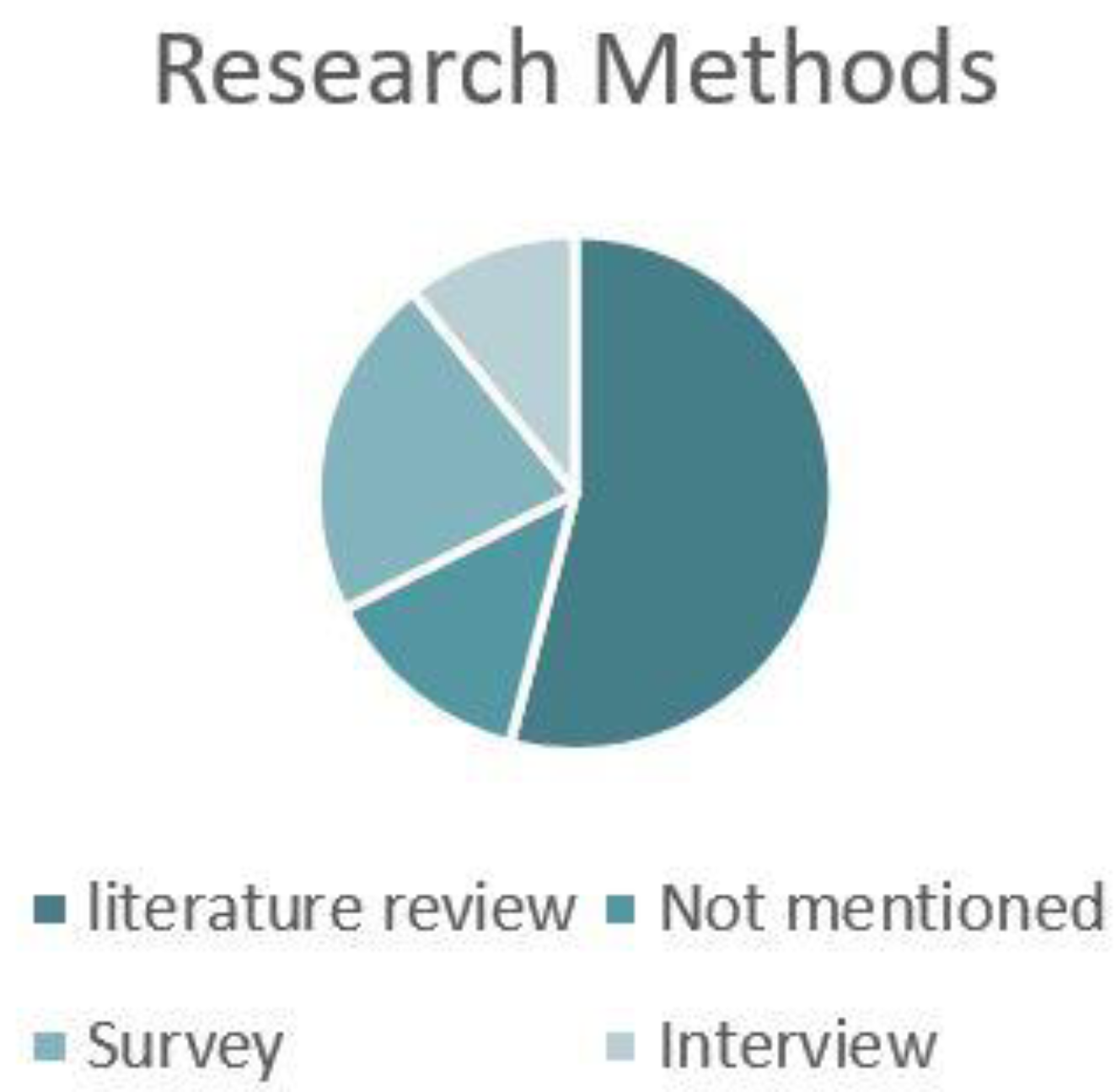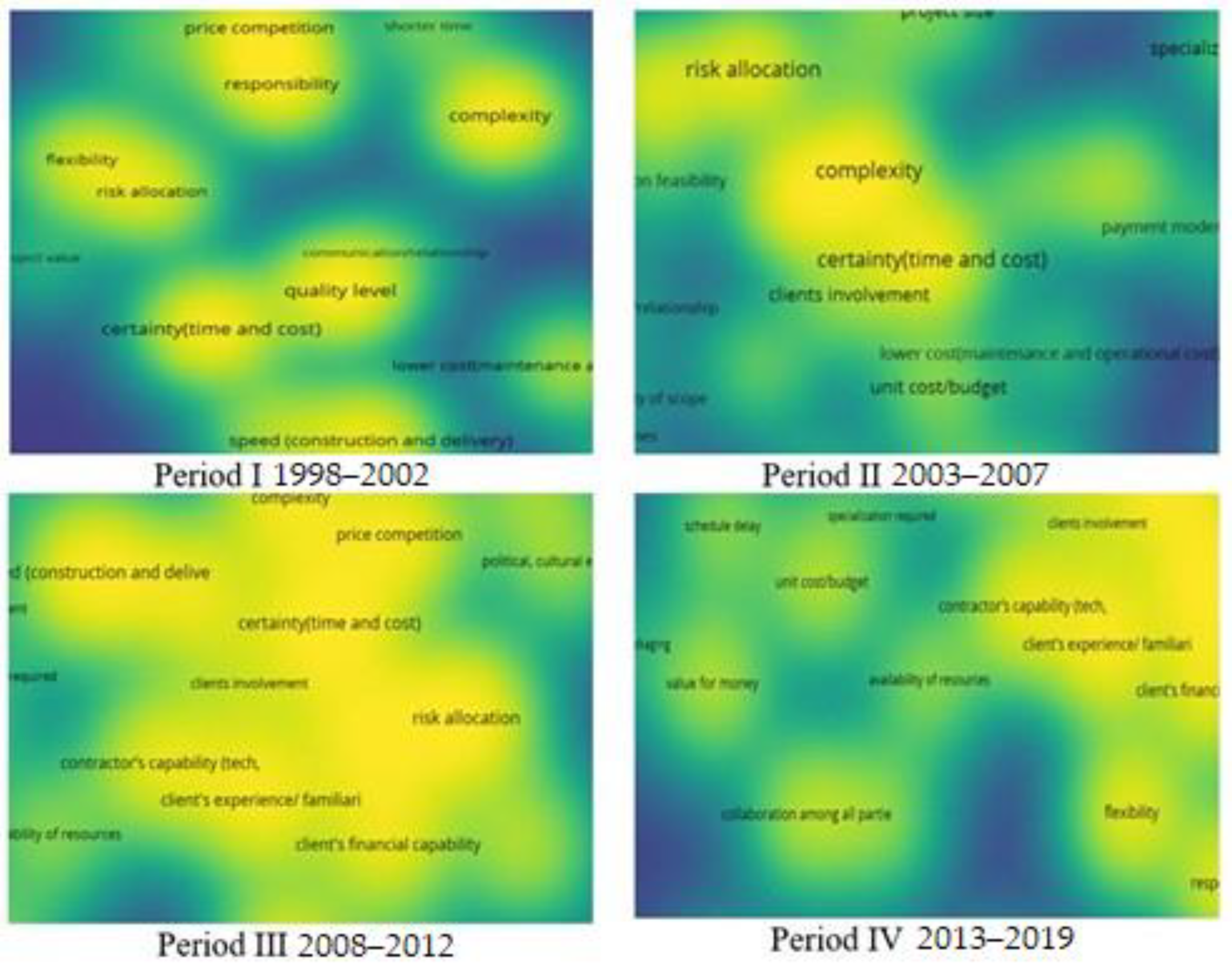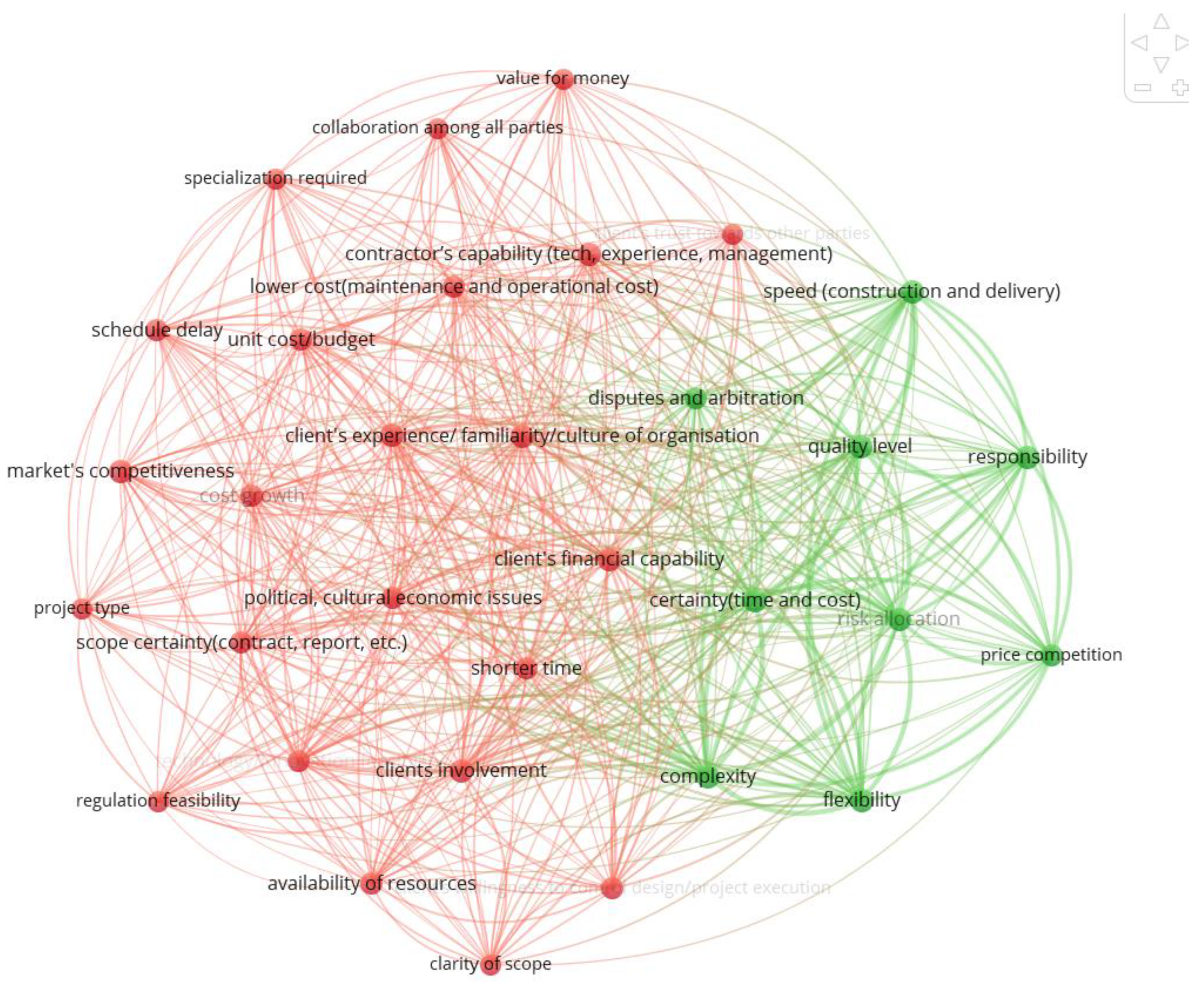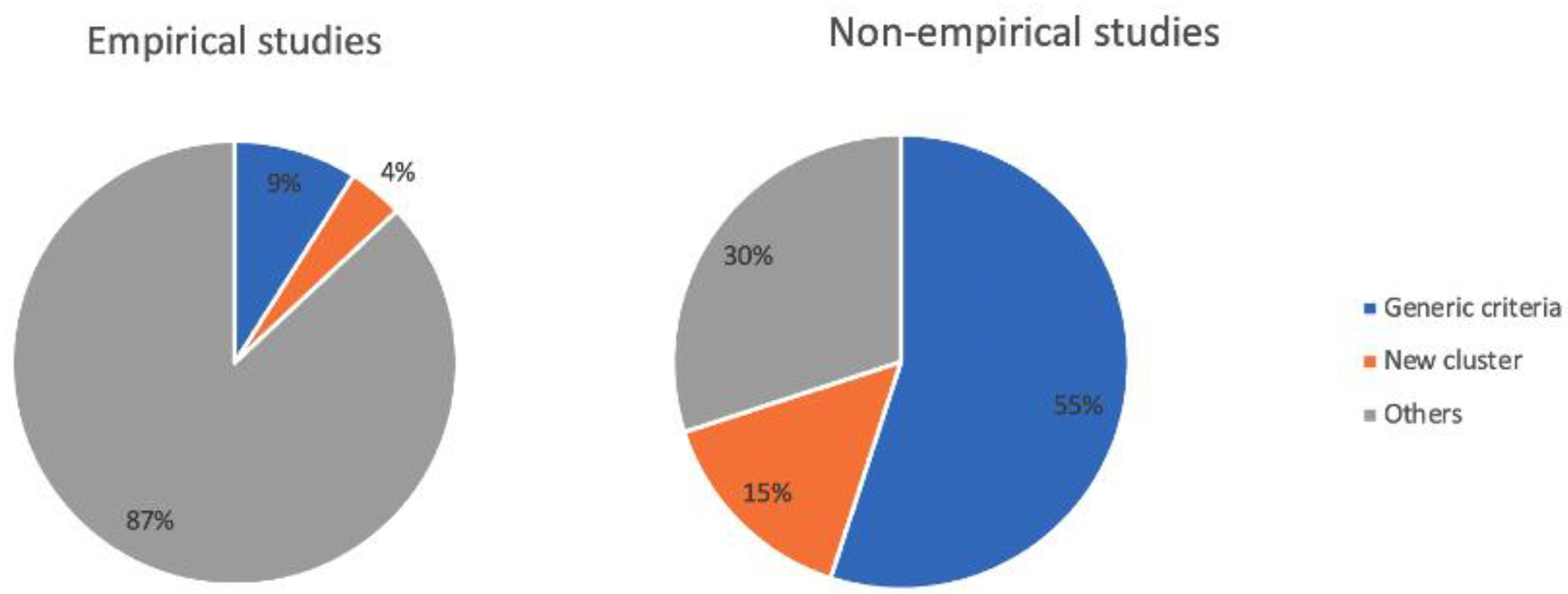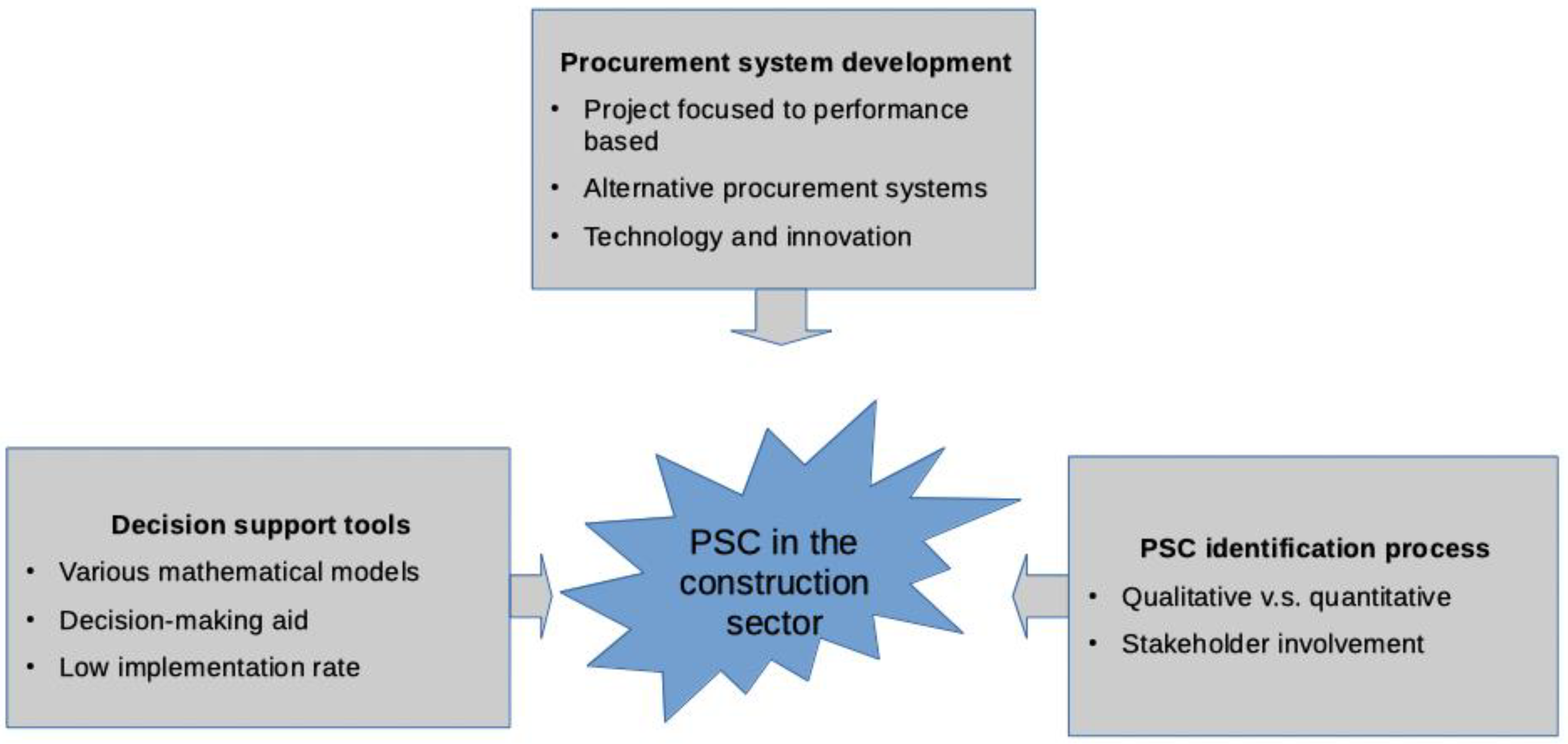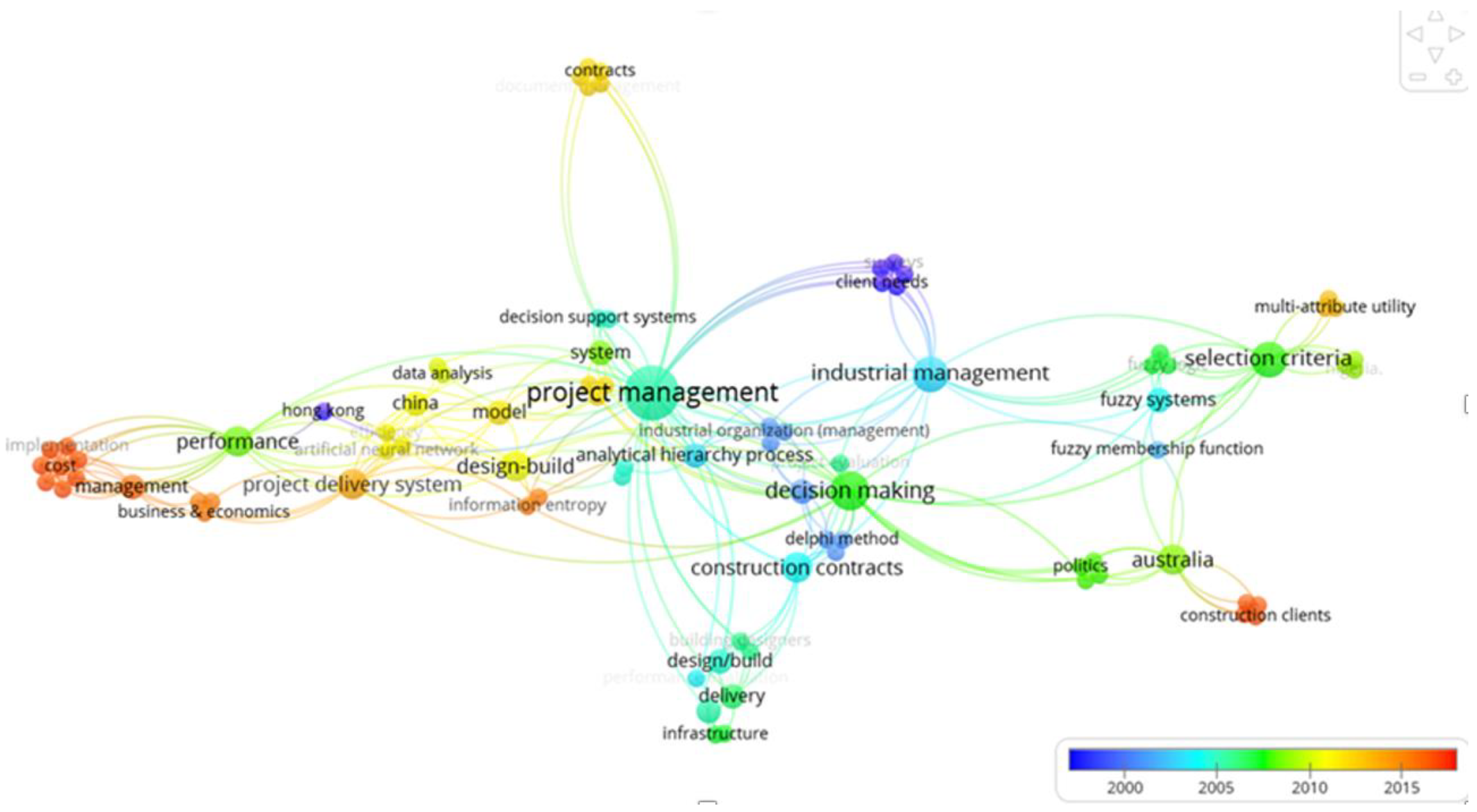1. Introduction and Background
Multiple ubiquitous issues emerge in procuring construction projects that impact client satisfaction. One of the most cited is that of the actual choice of procurement system to be adopted for the project. The issue of procurement system selection has been a subject of research for many years. The bulk of the interest has generally been situated in countries that adopted construction processes and legal frameworks built upon the UK system for historical reasons. These jurisdictions emphasized top choice on behalf of the client in setting up bespoke systems to take advantage of different aspects of the procedure, management process, and risk allocation. Hence, most procurement system selection research has historically originated in the UK, Australia (AU), New Zealand (NZ), and South Africa (SA).
Following the watershed Latham and Egan reports [
1,
2], construction practitioners have increasingly become aware of various procurement options [
3] and understand each procurement route contributes to project success in diverse degrees [
4,
5]. Extensive evidence shows that selecting an unsuitable procurement method may lead to significant problems such as cost and time overrun, disputes, and claims [
6,
7]. In addition, the critical innovative changes in the construction industry are the proliferation of procurement systems available for selection or, more correctly, creation [
8].
There is a certain degree of confusion about what constitutes a procurement system—particularly among those on the periphery of the industry. This, to a substantial degree, is the result of the conflation of procurement and purchasing. These are most certainly related but highly differentiated terms. Procurement systems describe how an organizational system assigns specific responsibilities and authorities to people and organizations, defining the relationship of various parties in the construction industry [
9]. The procurement process also indicates who leads the process, who designs different elements, who owns the risk, whose money purchases, who owns the intellectual property (IP), how data are processed, and how the product is ultimately handed over to the client—amongst a swathe of other elements. Advanced procurement systems have been introduced over the years with a raised awareness of the benefits of alternative procurement systems in construction projects. The systems evolved from the traditional system (e.g., separated method) to alternative procurement systems, such as the management-oriented method, integrated method, and collaborative method [
10].
While decision-makers are keen to seek the optimum procurement system for their project, there is no consensus on selecting a suitable one. To standardize the procurement selection procedures, researchers agree that there are two consecutive stages in construction procurement selection, namely PSC formulation and procurement selection, as summarized in
Figure 1. A plethora of research has discussed various aspects of PSC, such as systematic approaches for PSC analysis [
11], PSC in different contexts [
12,
13], and methods identifying PSC [
3,
14,
15]. These contemporary studies highlight the significance of PSC aspects in the procurement selection process.
Multiple frameworks guiding PSC identification have been developed over the years. For example, a Delphi technique was introduced to develop a selection model that would overcome the shortcomings of traditional multi-attribute decision analysis [
14]. Factor analysis was employed by Luu et al. [
15] and Chen et al. [
16] to elicit the underlying relationships among the eligible PSC. However, only a few have been adopted in practice, mainly because of the absence of a universally applicable set of criteria for procurement system selection [
3]. Studies have found various clusters of PSC to match the project context. Generic PSC, such as speed, certainty, flexibility, complexity, risk allocation, and quality level, have been identified in the early studies [
3,
7,
14,
17]. Since clients and stakeholders endeavor to choose the procurement system that fits the needs of the business, societal and environmental issues, and sustainability, construction procurement systems changed rapidly in recent years. The question arises of whether these PSC are still reliable in choosing the optimum procurement route in the modern construction industry. As a result, researchers seek state-of-the-art PSC to match the unfolding project context (e.g., value for money [
13], payment mode [
18], and building information modeling [
9]. While scholars recognize the need for considering modern concepts in PSC identification, limited research focuses on updating PSC and analyzing the trend of contemporary PSC. The first research question addressed in this paper is:
RQ1. What are the PSC identified in construction procurement, and what are the evolutions of these criteria over time?
Even though studies focused on PSC identification have been increasing, reviews of the procurement selection process are limited to date, emphasizing the need for systematic research regarding PSC identification and evaluation. The driver for applying systematic approaches is to ensure the identified criteria clusters are completed and robust when assessing the suitability of construction procurement systems. Given the variety of selection criteria, the paper’s objective is to understand the core line of PSC development, not only for historical reasons but also to identify the most viable directions for future research. Thus, the second research question is:
RQ2. What are the future research directions for systematic PSC identification?
We opted for a systematic literature review (SLR) with a specific focus on PSC in the construction industry to answer the above research questions. The remainder of the paper is organized as follows. First, the SLR protocol, the classification of the papers, and the analysis that led to answering the research questions are discussed. Next, the main findings from the collected corpus of papers are reported, distinguishing the selection criteria identified and their evolution over time, thus answering RQ1. The following sections then discuss the development of research topics, report the results of the analysis of the highly cited papers, and highlight four possible areas for future research that emerged from the study of the corpus, thus answering RQ2.
2. Research Method
The SLR is selected as the research method for this study because of the nature of the research questions, which aim at understanding trends and detecting existing gaps in the scientific literature [
19,
20]. An SLR is “a means of identifying, evaluating and interpreting all available research relevant to a particular research question, or topic area, or phenomenon of interest” [
21]. The SLR method has been used to consolidate emerging topics in other areas, such as social activities [
22], behavior research [
23], and construction management [
24].
A review is considered a “systematic” literature review if it is based on clearly formulated questions, identifies relevant studies, appraises their quality, and summarizes the evidence using a detailed methodology [
25,
26]. Hence, as an informative and evidence-based method, a systematic literature review overcomes the perceived weakness of a narrative review [
27]. Furthermore, an SLR provides a replicable research protocol and detailed documentation of the performed steps with the SLR [
19]. This enables an in-depth evaluation of the conducted study [
28].
This study followed the guidelines specified in prominent articles [
29,
30] to design a robust and replicable study. A three-step protocol was developed to identify a proper procedure for performing research that can be replicated by other researchers [
21].
First, a preliminary list of the keywords and inclusion criteria were identified. The concept of procurement selection criteria was defined by its various synonyms (such as procurement parameter, procurement indicator, and procurement factor) in the keywords, making our research as comprehensive as possible. Moreover, the study focused on papers published in refereed journals in construction management, project management, and construction economics from 1998 to 2019. The starting year was selected because, even though the term “selection criteria” first appeared in the 1980s [
31], the primary scientific literature push began around 1998. Conference proceedings and gray literature were excluded from the corpus, i.e., technical reports and works in progress. Therefore, the review was limited to peer-reviewed publications to gain consistency between themes and sources [
30] and to ensure the quality of the selected papers.
The search was launched based on the first set of criteria similar to that reported in
Table 1. Major publishers’ databases and library services, such as Springer, Emerald, Scopus, and Web of Science, were selected for the analysis. Following this, a double-blind control test was performed on 20 papers to verify and refine the selection criteria. The articles were selected manually to verify the papers’ coherency with the inclusive and exclusive criteria. Any paper that was met with disagreement was read and discussed within the research team until an agreement was reached. This led to the definition of the final selection criteria, as reported in
Table 1. The query was then relaunched, which resulted in the extraction of 239 papers.
The titles and abstracts of selected papers were reviewed. Papers out of the research scope were removed from the corpus following a discussion among the authors. One hundred twenty-two papers that did not focus strictly on selection criteria for procurement route selection in the construction sector but concentrated instead on a particular stage of procurement selection, such as contractor selection or supplier selection, were excluded. Similarly, papers investigating one specific product or service procurement, such as building service products or consultant services, were also excluded.
The last step of the protocol involved refining the list of selected papers. After reading the full versions of candidate papers, 82 articles were not in the scope of the research, i.e., mathematics modeling of procurement selection criteria evaluation, and were therefore excluded.
The references of all selected papers, i.e., reverse snowballing, identified the most cited articles with more than five citations from other papers already selected. If these most cited papers were missing from the corpus and coherent with inclusion criteria, they were added, leading to a final corpus of 37 articles.
The analysis and synthesis of the data extracted from the identified papers were conducted in two phases. Phase 1—Analysis I, a detailed analysis of identified PSC, addresses Research Question 1. Analysis II, an in-depth review of the identified PSC publications, was undertaken to respond to Research Question 2 in Phase 2. This is to determine the gaps in knowledge within the extant literature and identify common and emergent themes. The analysis is presented by summarizing, comparing, and synthesizing the characteristics and connections between the identified themes.
3. Analysis I: Identified PSC in Construction Procurement
Consequently, a total of 256 procurement selection criteria were identified in the corpus. The wide spread of identified PSC suggests that there is no consensus on selection criteria in the construction industry. Only 24 criteria have a frequency of over 5, as shown in
Table 2. Descriptions of the criteria are vague and fuzzy, such as culture or applicability. Most of the literature did not explain the definition and context of the criteria. It appears there is a high degree of subjectivity and intuitive judgment in PSC identification. These criteria cover various players, levels, and stages of construction projects. The performance of contractors, consultants, and clients is considered in selection criteria, such as the client’s management ability and the consultant’s staffing level. Criteria relating to the strategic level, such as risk allocation and economic environment, are listed as well as the ones at the operational level, for instance, availability of materials and equipment. The vagueness and fuzziness of the definition of PSC may lead to difficulty in their evaluation.
Similarly, there is limited agreement on PSC classification. Fifteen different combinations of categories are established in the corpus literature. At the same time, some papers suggested categories such as project characteristics, client requirements, project objectives, and external environment [
32]. Others proposed certainty, price competition, flexibility, complexity, quality, responsibility, and risk [
33]. It is apparent that there is no systematic mechanism in PSC identification and classification.
For this reason, a citation network analysis is carried out to figure out how the PSC were identified and what research method was used. The classification of research methods employed in criteria identification is reported in
Figure 2, where each paper could adopt more than one methodology. However, the maximum number of methods per paper in the corpus is two. The literature review is the most frequent method used in the corpus. This leads to a citation network analysis, aiming to determine the original source of PSC. As illustrated in the citation network (see
Figure 3), the most-cited papers in the corpus are an indicator adopted to measure the impacts and contribute to the PSC category analysis. The results show that NEDO [
32] has been most frequently cited in the last three decades. The detailed frequency of highly cited papers for PSC identification is displayed in
Figure 3. It is noted that a significant number of the articles used the criteria identified in Love et al. [
7], as highlighted in red. Citation network analysis suggests PSC identification is highly literature review-based, focused on limited high-impact papers that have not been updated since 2002 [
34].
All PSC were fed into a Java program to identify the trends that appeared from 1998 to 2019. All PSC are mapped in a five-year interval, as shown in
Figure 4. The density visualization of PSC reveals the evolution of each criterion and the core clusters of a specific time interval.
Overall, the density visualization in period I is dispersed. Some indicators related to collaborative systems have emerged during this period, such as the client’s financial capability [
11], the client’s involvement [
14], and collaboration among all parties [
5]. Focusing on articles published in period II, it appears that mathematical models for procurement method selection are given a higher priority. It seems that the growing project complexity stimulated new payment modes at this time [
18]. Regarding period III, the client’s financial capability and technology/innovation feasibility became key PSC when assessing procurement systems. This could explain the increased use of collaborative approaches in construction procurement. Similar to period I, the density in period IV is disbanded. Some PSC, such as value for money, client’s willingness to take risks, collaboration among parties, contractor ability, and political issues, obtained more attention. However, such studies updated the PSC from extant studies, not from empirical research [
35].
A more realistic reference revealing an unclear classification of PSC leads to a fuzzy boundary for each criterion. The obvious logical follow-up question is how to best group the criteria into different categories. A network is established based on shared criteria relations, and
VOSviewer automatically generates this classification without manually creating the groups, as shown in
Figure 5. The main PSC have been broadly classified into two clusters: “generic criteria” (in green) and “non-generic criteria” (in red).
Figure 6 represents the PSC identified through empirical studies, such as interviews and surveys. Only two papers used generic criteria in these studies, while the rest identified various PSC from different economics to fit the project contexts. Among the non-empirical studies, 11 articles (30%), such as [
36], identified generic criteria from extant work. A small amount of new clusters of PSC has become a consensus of three articles [
12,
15,
37].
The high percentage of different samples from empirical studies reveals that researchers prefer to examine the individual clusters of PSC to fit various situations. Perhaps the most problematic issue was identifying the PSC related to the requirement of updated procurement methods, which consider catering to changes in industry culture and practices. Consequently, the results of identified papers imply a tendency of modern PSC: PSC should contain generic and unique criteria, depending on the project context.
In addressing RQ1, 256 PSC have been identified and analyzed. With the continuing trend in procurement systems development, PSC identification has become essential for selecting the optimum procurement option. Since there is no consensus on how the PSC should be identified, researchers cannot decide the “correct” way of listing PSC. The findings explore how PSC have evolved. Although some existing studies have examined different clusters of PSC, not all aspects of PSC have been considered. According to our review, the clearstories of these PSC could provide insight for researchers to explore PSC identification [
12,
15,
37].
Subsequently, it is critical to ensure the optimal PSC is selected using a robust and repeatable process. The challenge here is complex variables obtained in identifying unique criteria. Forty-seven percent of the corpus identified PSC through empirical study and produced a different set of standards for determining the appropriateness of a procurement system. Luu et al. [
15] argued that those criteria have no clear definition (scope). At the same time, Rowlinson [
38] indicated that a selection criterion should contain an amalgamation of various unique parameters due to the project’s uniqueness. Ng et al. [
3] pointed out that fuzziness may exist in nature, which means assessing PSC may require decision-makers’ judgments. The identified PSC cannot achieve a robust result because it involves too many subjective decisions, and the classification is not systematic. Thus, compelling issues related to research gaps in procurement selections need to be considered.
4. Analysis II: In-Depth Review of Construction Procurement Selection Criteria
Research gaps in the literature are identified to provide an avenue for future lines of inquiry. This systematic review has identified several emergent themes, which are summarized and critically reflected upon. As noted in
Figure 6, these themes are (1) procurement systems, (2) decision aid tools, and (3) procurement selection process.
4.1. Procurement System Development
All keywords of the corpus were analyzed to identify the trends of research topics using
VOSviewer. As shown in
Figure 7, the color bar indicates the average years of publications. The higher the frequency of an item, the larger the circle of the item. The “hottest” spots in the figure are “project management”, “decision making”, and “performance”.
Most attention from earlier papers is at the micro-level, considering the contribution of PSC for individual project procurement selection. For this reason, “project management” has 36 links related to other keywords, as shown in
Figure 8. The purpose of project management is to achieve the balance of triangle elements through procurement success. In the later decade (2008–2019), research expanded to consider more PSC to match the construction context. Therefore, the research topic is seen to emerge from “industrial management” to “decision making” and “performance”. It is important to note that “industrial management” has not been the key research area since 2008. Recently, the research keywords moved from “decision making”/“performance” to new areas such as “contracts”, “politics”, “model”, “framework”, “relationship”, and “management”. These two keywords express the characteristics of alternative procurement systems.
PSC were updated following the trend of procurement system development. Overall, PSC concerning project management (“shorter time”, “project type”, “regulation feasibility”, and “lower cost”) have been mentioned by early articles. PSC then tend to focus on broader aspects of the procurement method selection process. Contemporary elements, such as political, cultural, and economic issues, have been examined [
32,
39]. Clients’ financial capability has been discussed [
35,
40,
41].
In the meantime, collaborative procurement systems such as public–private partnerships (PPPs) and private finance initiative (PFI) started their implementation in the construction industry. It seems that procurement policy and clients’ needs drove the changes in procurement practice. For instance, the UK government promoted a paradigm shift from traditional methods to value for money and a collaborative environment after the publication of “Accelerating Change” in 2002 [
42]. The availability of procurement system alternatives significantly influences the definition of project success elements, such as collaborations and long-term relationships. Consequently, PSC were updated to reflect the changes demanded by emerging procurement system alternatives. Modern PSC, such as collaboration among all parties and availability of resources, started to gain popularity.
Further investigation of research topics about “decision making” and “performance” shows that PSC have contained broader aspects and refined scope since alternative procurement systems developed, as presented in
Figure 9. For example, contractor’s capability and collaboration among all parties have been extensively discussed in the last five years. For the public sector, it is essential to utilize a variety of procurement methods to allocate responsibility and risk among supply chain parties [
43]. For construction procurement, it has been widely acknowledged that the requirement of an integrated supply chain is “value for money”. “Value for money” was first recognized as a criterion in 2004, and it became a fashionable criterion that 14% of papers have mentioned. In addition, the definition and scope of PSC should be updated if new procurement systems emerge. The previous section has explored the description of one criterion. Researchers found that clients seek a better and more accurate procurement method to achieve their objectives. Thus, the client’s requirements were mentioned in the early years [
6], disappeared in the middle term of the period, and were discussed by authors in 2017 [
10] to reflect the updated requirements.
Furthermore, new technologies are continually changing the essence of modern construction. Construction innovation stimulates the proliferation of procurement systems and the intricate design of projects. Current demands of PSC are thus promoted as it improves the probability of success in complex construction projects. An innovative design could save time, costs, and cost of change [
9]. This would explain why “lower cost” and “short time” have not been frequently discussed since 2006. Meanwhile, challenges emerged regarding the use of new technology, such as whether the clients/contractors/engineers are familiar with the named technology and whether the market has available resources to implement the technology. Public policy became the driving force for change due to the innovative activity of construction [
8].
4.2. Decision Support Tools
A plethora of mathematical techniques have been developed to assist decision-makers in reaching an informed decision in procurement route selection [
3,
15,
32]. Data analysis illustrates that decision aid tools such as analytical hierarchy process (AHP), fuzzy theory (FT), multi-attribute utility technology (MAUT), and artificial neural network (ANN) were the main topics over recent years, as shown in
Figure 8. It seems there are significant links between “decision making” and “mathematical techniques”, “performance”, and “model”, which indicates the increased tendency to apply decision aid tools in the procurement selection procedure.
While there is an expanded interest in research regarding decision-making aid tools in construction procurement selection, few of the tools have been adopted in the industry. The findings reveal more than half of the articles in the corpus developed a framework utilizing specific tools [
7,
44,
45,
46]. In addition, evidence in the studies agreed that the robustness of the selection process is enhanced using decision aid techniques, as it is believed that mathematical methods could solve the inherent complexity of PSC identification (e.g., the nature of PSC) and improve the accuracy of PSC evaluation (e.g., pairwise comparison) [
3,
47]. However, there is minimal research centered on its application in real-world practice.
4.3. PSC Identification Process
Few studies that consider the PSC identification process have shown how these PSC could be identified, especially in terms of the methods. Quantitative research methods have been widely used in the identification process. The problem is few authors identified the specifics as to why they adopted quantitative methods for their research; in other words, why should PSC be collected from numbers and statistical results? Researchers are now aware of the evaluation of procurement systems, and they agree that identifying the factors influencing the choice of procurement system is not only to recognize a pattern. It could also help expand the classification problems, such as classifying project delivery systems [
41].
The fact is limited studies debate the relationship between procurement systems and PSC. Instead, PSC identification is becoming the study of expressed sentiments of stakeholders rather than a systematic analysis of “project performance”. Generally, survey questionnaires were distributed to key stakeholders to identify PSC and/or assess each criterion. For example, Smith et al. [
13] tended to collect the views of clients, contractors, consultants, designers, and academics, from both the public and private sectors. Their research attempts to identify the factors influencing the choice of procurement methods. With the same aim, a survey [
48] chooses distinct groups of the study population: consultants (architects, surveyors, engineers, and builders), clients, and contractors. We assumed the geographical location provides diverse participants in the studies. While Liu et al. [
41] focus on the same country as Smith et al. [
13], clients, designers, supervisors, and contractors were targeted for the survey. Although those studies led researchers to understand the practices in contrast with the idealized ones (only from the literature), the researchers would not achieve a robust result without a clear scope of targeted respondents.
Furthermore, perceptual deviations in unique criteria were assessed by various participants. For example, managers believed “market competitiveness” had a substantial impact on the choice of the procurement system. In contrast, clients argued that it had medium effects only [
15]. A precise method, therefore, should be clarified in future research.
5. Future Research Directions
In addition to identifying the PSC and their evolutions in construction procurement, the perusal of the literature on construction procurement allowed us to identify some directions for research that deserve further investigation by academics and practitioners.
5.1. Criteria Definition
The first research opportunity is about the PSC themselves and the knowledge gap of extant studies. To better understand PSC, Analysis I addressed the fuzziness in the nature of PSC and discussed how the PSC could be categorized. Yet, further research still needs to provide the scope and definition of each criterion clearly and comprehensively. The up-to-date PSC are related to the evolution of the procurement system. As stated above, PSC could contain several clusters of PSC. However, it remains unclear how exactly PSC can be identified in choosing an optimum procurement system. A more accurate determination of each criterion can provide objective results that reduce the fuzziness in PSC identification. It is expected that defining PSC could be analyzed to provide the PSC boundary facing the continuous evolution of procurement systems.
5.2. Develop the Link between Procurement Systems and PSC
The second possible research avenue that comes from the finding is that the PSC are evolved to match the development of procurement systems. Notably, the research topics developed from industrial management to project management and finally changed to more expansive areas. Due to the changes in research topics, the scope of PSC increased from simple to multiple fields to achieve the requirements of clients and projects. Researchers are now aware of the development of procurement systems. The fact is limited studies debate the relationship between procurement systems and PSC. Despite this, this paper found PSC evolved along with the development of procurement systems.
Further research would explore how each criterion connects to each procurement system and how PSC can contribute to procurement system selection. The analysis of methodologies applied to study PSC indicates that modeling methods are the dominant methods used, while half of the selected papers explored PSC using a questionnaire survey. Research on the procedures for procurement system selection could be an additional research avenue.
5.3. Exploring the Factors Influencing Unique Criteria
The third research opportunity is related to the finding of PSC classification. A cluster of PSC named “generic criteria” was identified by most studies and continuously attracted researchers’ interests during the last two decades. The results indicate another set of PSC, unique criteria, emerged due to the development of procurement systems. PSC practices showed that geographic location may not impact the choice of procurement systems; nevertheless, we still failed to address what factors influence procurement selection. Recognizing it could help better understand the client’s needs and achieve the optimum procurement system.
5.4. Establish a Framework for PSC Identification
The extant literature offers solid support for adopting alternative procurement systems in the real world, but the process of PSC identification is yet to be confirmed. Naturally, it would have been expected that the issues encountered with PSC identification should have prompted a systematic method to achieve an objective result, but it has not seemingly occurred.
Figure 7 indicates the research interests of mathematical model establishment, while unsolved issues remained without a guideline of PSC (particularly, unique criteria) identification and evaluation. Therefore, there is a pressing need to produce a comprehensive framework that could systematically identify and evaluate PSC. The results show that PSC could be collected from empirical studies in different economics and could be extracted from the extant literature. As many ways of identification could potentially lead to objective judgments and evaluation, a framework is a possible solution to address these shortcomings of current identifying methods as well as systematically providing a comprehensive approach to the delivery of PSC identification. The essential suggestions for PSC identification are to clarify the methodologies, the decision-makers, and respondents if PSC should be collected from the industry. Recognizing the need to consider critical elements for PSC identification, the decision-makers will gain more resources to identify PSC clusters.
6. Conclusions
The proliferation of procurement systems encourages clients to pursue appropriate and costumed procurement methods to achieve better performance [
8]. Identifying PSC is the first step in the procurement selection process. Despite its importance and increasing relevance, the literature on PSC is quite fragmented, thus hindering a holistic understanding of the topic and making it challenging to highlight the gaps that must be addressed. To understand the field’s existing theoretical and practical foundations, a systematic literature review of peer-reviewed journal articles in construction procurement selection is carried out to respond to the up-to-date procurement selection criteria identified and establish a link for PSC identification.
Regarding Research Question 1, 256 PSC have been identified and analyzed. The SLR illustrates that the main PSC evolved to match the promotion of emerging procurement systems in the construction industry with the following three aspects. Firstly, the emerged PSC, such as “value for money” and “contractors’ ability”, are modernized due to the updated procurement systems. Secondly, PSC considered broader areas of procurement systems since the shifts in technologies and legislation. Additionally, the results show that research topics have been moving to more complex areas to fit the requirements of modern projects and construction clients. However, further research is still needed to understand how exactly PSC contribute to procurement selection.
The second finding of this paper is the key themes of debates on PSC from the extant studies that shed light on how PSC could be identified and analyzed to date. The analysis shows that scholars’ interests focus on alternative procurement systems, decision aid tools, and PSC practice. The three streams of themes could give the researcher a roadmap on PSC topics and provide the foundation and impetus for further investigation into procurement system selection practices.
The third contribution of this paper is the categorization of the PSC addressed. The updated PSC could be generally classified into two clusters. Through analysis of the evolvement of PSC and the nature of PSC, PSC contain generic criteria and unique criteria depending on the project context. All generic criteria have been provided with a concise description. Therefore, further research could focus on identifying unique criteria.
The fourth finding comes from an analysis of unique criteria. Although the fuzzy nature of PSC and unclear boundary of PSC description led to challenges in PSC identification, the result shows that geographic location is not a factor influencing the choice of procurement systems. This finding may allow researchers to rethink future PSC identification methods.
It is essential to acknowledge, however, that the review has limitations. This paper only considered peer-reviewed journal articles in the last three decades, which means some relevant information may be excluded. In addition, there may still be the possibility of subjectivity—for example, the classification of research methods. However, the review procedures are well designed with a step-by-step structure that could guide further research development. Importantly, this paper remains a significant contribution to up-to-date procurement selection criteria in modern construction. It provides the foundation and impetus for further investigation into procurement system selection practices.
